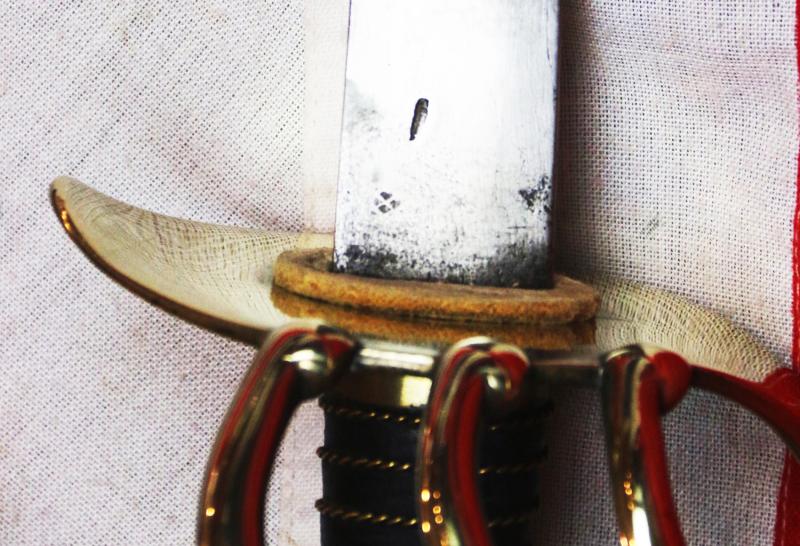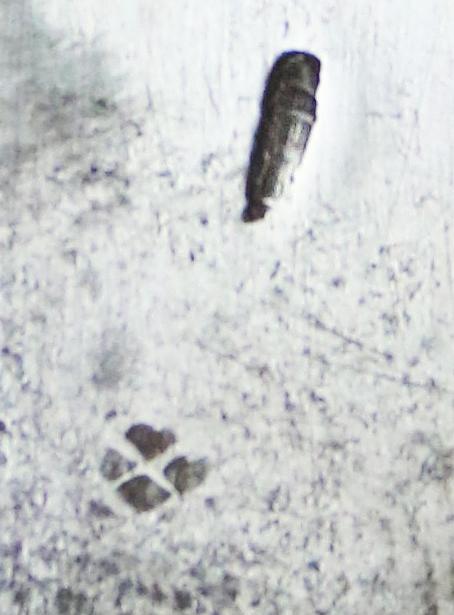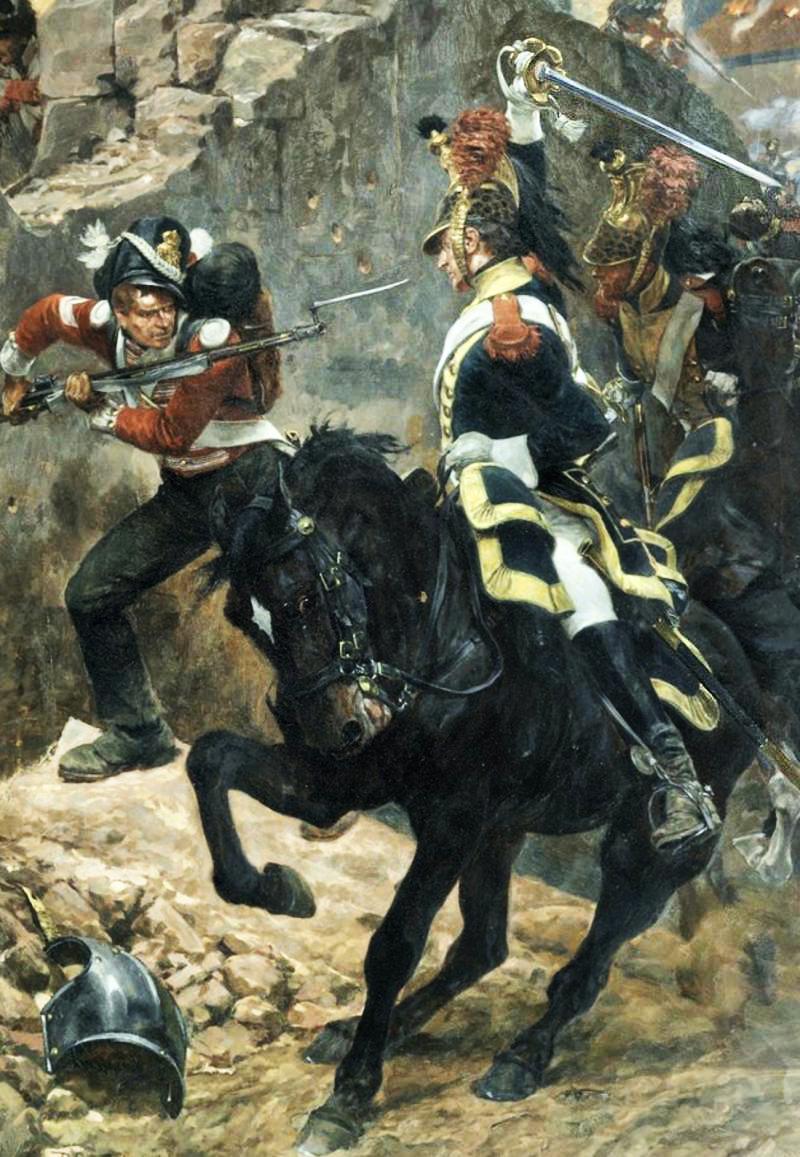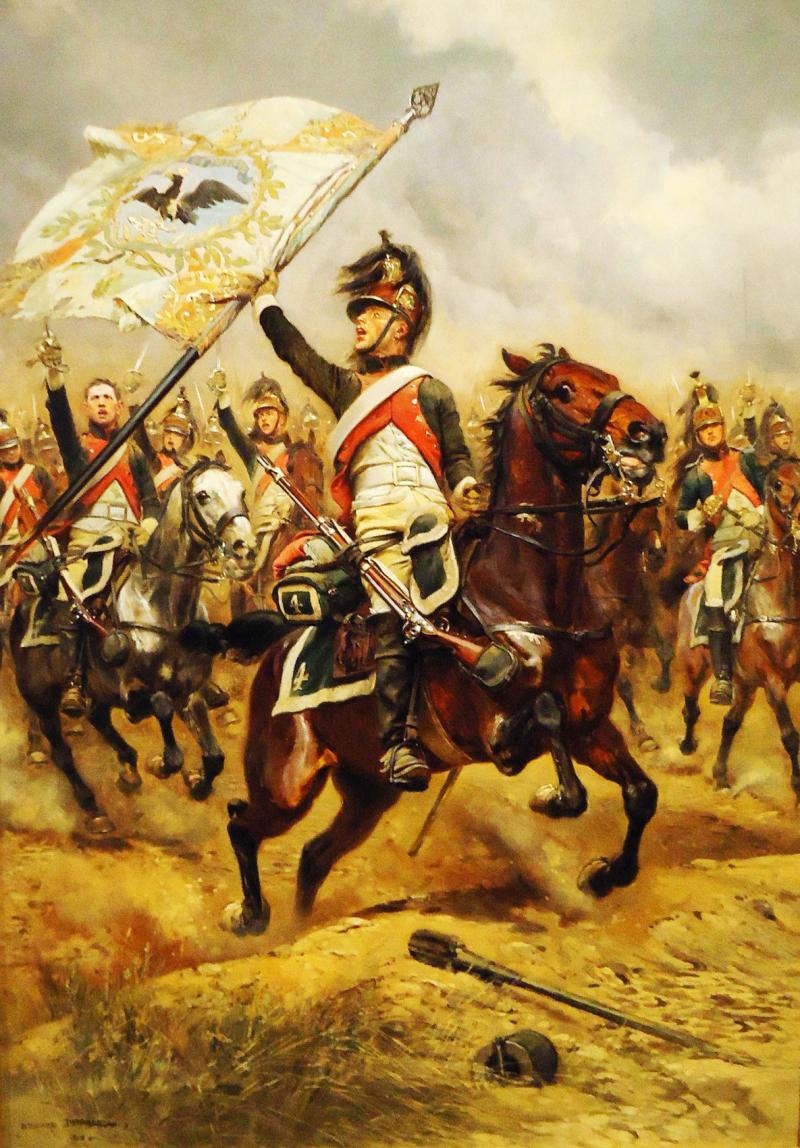A Superb, French, 1st Empire Napoleonic Wars Cuirassier-Dragoon Sword In Fabulous Condition With Brass and Leather Scabbard
Blade stamped with the mark of the Fasces and Phygian cap for the 'Petit Garantie' 1798 to 1809.
With superb and rare brass mounted leather scabbard, brass 4 bar hilt with wire bound leather grip. Circa 1806. The blade is the rare, earliest, flat sided type, used from the Consular period and the 1st Empire.
The role of the cuirassier cavalry was to be in reserve during the battle, they had to wait to hit the enemy at the right time – this is the reason why Napoleon was angry at General Ney that had involved the cuirassiers two hours earlier in the Battle of Waterloo.
Cuirassiers and Carabinieri played a similar role; their called reserve or heavy cavalry. The idea of creating a heavy smashing cavalry originated with the First Consul after the Battle of Marengo. By observing the effectiveness General Kellermann, when the cavalry reduced the strength of the Austrian infantry by half – Bonaparte realized the important potential of a cavalry attack at the right time.
Quote from the Duke of Wellington:
"Napoleon won the battle using cuirassiers as a kind of accelerated infantry with a multitude of weapons, he had a habit of capturing large parts of the enemy's central troops before his infantry could advance."
The birth of the cavalry specialized "Cuirassier" dates back to October 10, 1801. The 1st and 8th Cavalry Regiment were merged into this new corps, and only the 8th Regiment wore armour and until the revolution was called the King's Cuirassiers, they had to keep their armour as an honorary title. Consequently, the first cuirassier regiment would also have been able to carry this armour.
This would have seen service in the Elite Cuirassiers and Dragoons of Napoleon's great heavy cavalry regiments of the Grande Armee such as in 1807 at Friedland. And in the French invasion of Russia ( Campagne de Russie) that began on 24 June 1812 when Napoleon's Grande Armee crossed the Neman River in an attempt to engage and defeat the Russian army. Napoleon hoped to compel Tsar Alexander I of Russia to cease trading with British merchants through proxies in an effort to pressure the United Kingdom to sue for peace. The official political aim of the campaign was to liberate Poland from the threat of Russia. Napoleon named the campaign the Second Polish War to curry favour with the Poles and provide a political pretence for his actions. The Grande Armee was a very large force, numbering nearly half a million men from several different nations. Through a series of long marches Napoleon pushed the army rapidly through Western Russia in an attempt to bring the Russian army to battle, winning a number of minor engagements and a major battle at Smolensk in August. Napoleon hoped the battle would mean an end of the march into Russia, but the Russian army slipped away from the engagement and continued to retreat into Russia, while leaving Smolensk to burn. Plans Napoleon had made to quarter at Smolensk were abandoned, and he pressed his army on after the Russians. The battles continued, but once the winter set in Napoleon's army was facing insurmountable odds that left it effectively shattered beyond repair. Napoleon fled, it is said, dressed as a woman, and the army left to it's sad and miserable fate. Only around 27,000 were able to return after a mere six months of the Russian campaign. The campaign was a turning point in the Napoleonic Wars. The reputation of Napoleon was severely shaken, and French hegemony in Europe was dramatically weakened.
The Grande Armee, made up of French and allied invasion forces, was reduced to a fraction of its initial strength. These events triggered a major shift in European politics. France's ally Prussia, soon followed by Austria, broke their alliance with France and switched camps. This triggered the War of the Sixth Coalition. The Cuirassiers Heavy Cavalry Regiments used the largest men in France, recruited to serve in the greatest and noblest cavalry France has ever had. They fought with distinction at their last great conflict at the Battle of Waterloo in 1815, and most of the Cuirassiers swords in England very likely came from that field of conflict, after the battle, as trophies of war. Every warrior that has ever entered service for his country sought trophies. The Mycenae from a fallen Trojan, the Roman from a fallen Gaul, the GI from a fallen Japanese, the tradition stretches back thousands of years, and will continue as long as man serves his country in battle. In the 1st century AD the Roman Poet Decimus Iunius Iuvenalis Juvenal
wrote; "Man thirsts more for glory than virtue. The armour of an enemy, his broken helmet, the flag ripped from a conquered trireme, are treasures valued beyond all human riches. It is to obtain these tokens of glory that Generals, be they Roman, Greek or barbarian, brave a thousand perils
and endure a thousand exertions". A truly magnificent Napoleonic sword in superb condition for it's age.
The largest sword of it's kind that was ever made or used by the world's greatest cavalry regiments. The cuirassiers were the greatest of all France's cavalry, allowing only the strongest men of over 6 feet in height into it's ranks. The French Cuirassiers were at their very peak in 1815, and never again regained the wonder and glory that they truly deserved at that time. To face a regiment of, say, 600 charging steeds bearing down upon you mounted with armoured giants, brandishing the mightiest of swords that could pierce the strongest breast armour, much have been, quite simply, terrifying. The brass basket guard on this sword is first class, the grip is later wire bound leather and a great colour, the blade is absolutely as crisp as one could hope for. Made in the Napoleonic Wars period.
Just a basic few of the battles this would have been used at such as
Friedland in 1807,
in 1812 and beyond 1812: Borodino and Moscow, Ostrowno, and Winkowo 1813: Reichenbach and Dresden, Leipzig and Hanau
1814: La Rothiere, Rosnay, Champaubert, Vauchamps, Athies, La Fere-Champenoise and Paris
1815: Quatre-Bras and Waterloo. The blade has fabulous steel bright colour, and hilt has fabulous patina. Overall 45.75 inches long in its scabbard, the spear pointed blade is 37.5 inches long. Just old aged staining to the scabbard steel.
The French Elite Cuirassier & Dragoon Sword is surely one of the most impressive Heavy Cavalry swords ever made, being of incredible size quality and stature. Used in the great campaigns of Napoleon by the Elite Grande Armee Cavalry, from Austria through the Russian Campaign, into the Peninsular War and finally the The Battle of Waterloo. All the Cuirassier were front line regiments, none ever utilized as Militia. With brass mounted leather scabbard, multi fullered blade, brass 4 bar hilt with wire bound leather grip. Circa 1806. The blade is the earliest flat sided type and bearing the matching Fasces and phygian cap stamp of circa 1806.
As First Consul, Napoleon would inherit 20 understrength dragoon regiments. In 1801 every cavalry unit by Consulate order would create an elite company in every regiment to guard the regimental eagle. These "elite" companies would receive an extra pay referred to as the "pay of the grenade." Napoleon would re-equip six cavalerie and three hussar regiments as dragoons. Five years later, in 1804 would see their greatest extent of numbered units at 30 regiments. 1806 in a move to increase the size of his cavalry, instead of creating new regiments, Napoleon would expand every regiment to 5 squadrons.
In 1808 Napoleon sent 24 dragoon regiments to Spain to gain experience, and the remaining six went to Italy. The six in Italy would be involved in the 1809 campaign and go to Russia in 1812. The future called "dragoons of Spain" would cut their teeth and evolve into a fiercely experienced arm of Napoleon's army. They were often utilized as heavy cavalry given there was only one cuirassier regiment in Spain and were pitted against the more experienced and heavily armed British heavy cavalry. The six long years fighting against guerillas and in the Peninsular War would grind the dragoons down to small effective units. They were commented on as the most effective cavalry units when withdrawn to France in 1814.
In 1811 foreseeing war with Russia inevitable, Napoleon would convert five into lancer regiments, and by 1815 only 15 regiments would remain.
Code: 25292
2950.00 GBP










